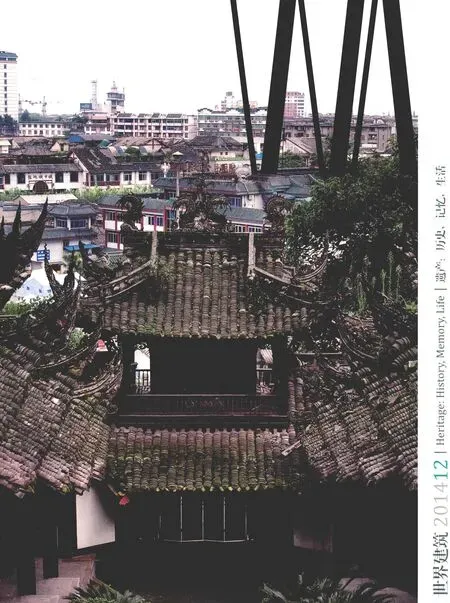贾平凹文学艺术馆,西安,陕西,中国
项目设计:刘克成/西安建筑科技大学
贾平凹文学艺术馆,西安,陕西,中国
项目设计:刘克成/西安建筑科技大学
贾平凹先生是有广泛世界影响的中国当代著名作家和艺术家。为了展示作家的成长过程和创作经历,展示作家的文学成就和创作生活,并为文学爱好者提供一个学习文学、交流经验的场所,西安建筑科技大学决定在校园内为著名作家贾平凹先生建立“贾平凹文学艺术馆”。
贾平凹文学艺术馆选择1970年代建设的一栋旧楼进行改建。原建筑为砖混结构,上下2层,局部3层,整体平淡无奇,但地处校园历史地段,为学校的历史建筑之一。
我们认为此馆应当继承1970年代学校的遗产,并一直延续下去;它应当保持1970年代的真实性,拒绝粉饰;它应当将老建筑合法化,并结合新的功能,予以全面提升,赋予它新的生命力。因此,我们确定这样一个原则——在改造完成以后,这栋建筑还应当保持1970年代的面貌和特征。在这里,历史和现实应当是一种对话关系,而不是服从关系。
设计的最初启示来源于阳光。经过多次现场体验,设计者发现:对这个平淡、朴实无华的建筑,光影的流盼是其最具魅力的特征。从早晨6∶00到下午19∶00,每隔一小时拍一张照片,然后进行连续播放,可以看到由阴影构成的一个体量发生着一个有趣的变化。光影是隐藏在这个建筑中的灵魂。于是建筑师选择光影作为设计的重点,在原建筑东南面增加了一个曲折的光廊。光廊造型来源于一天24小时建筑光影的叠加,也象征贾平凹故乡起伏的山川和乡村。当时光流转,光廊形成的长长的影子,划过旧建筑的墙面,抚摩镌刻在墙上的作家诗句,爬上书架——光与影,新窗与老墙,微风与绿树,城市与乡村,文学与艺术,时间与空间,拼织出一幅丰富的图像,一种文学的诗性油然而生。
建筑保留原有的清水砖墙、外刷深色涂料的基底,选择玻璃、钢架和混凝土3种原建筑没有的词汇作为新因子介入。老建筑基本维持不变,新构件以对话的方式与老建筑并置。
钢架、玻璃与混凝土依据光影变化,统一到同一形式逻辑,打破原建筑的平庸和呆板。钢架分主框架、次框架和装饰性框架3层,以不同角度和密度,形成新老元素的和谐对话。
钢筋混凝土墙采用俯首可得的建筑废料——竹条作为模板浇注,形成粗糙而又富于肌理的表面,在密度上与清水砖墙和谐,在文化上造成一种与陕西农村普遍使用的“干打垒”墙体类似的效果。
正如一个文学评论家所说:贾平凹文学艺术馆就像作家本身外表朴实、内心空灵的性格,它为爱好文学艺术的人们,提供一个触摸贾平凹灵魂的场所,在貌似平淡的空间中,感受到了世界的精彩!
项目信息/Credits and Data
总建筑面积/Gross Floor Area:2000m2
建筑高度/Building Height:地上最高点10.1m/10.1 m for the highest point above ground
建筑层数/Number of Floors:地上3层/3 floors above ground业主/Client:西安建筑科技大学/Xi'an University of Architecture and Technology
建筑设计公司/Company for Architectural Design:西安建筑科技大学/Xi'an University of Architecture and Technology
JIA Pingwa is a worldwide influential, wellknown contemporary Chinese writer and artist. In order to display his upbringings, creative experience and life and literary achievements as a writer, and in order to provide lovers of literature with a site for literary study and scholarly exchange, Xi'an University of Architecture and Technology decided to build the Jia Pingwa Literature and Art Gallery on its campus for Mr. JIA.
An old building constructed in the 1970s was chosen to be remodeled into Jia Pingwa Literature and Art Gallery. The original building, with its brickconcrete structure, had 2 floors as a whole, a part of which had 3 floors. The whole building was one of the University's historic buildings by virtue of its prestigious location, although it appeared to be trite and insignificant.
We thought that this gallery should inherit the university's heritage of the 1970s and carry it forward; it should keep the truth of the 1970s instead of whitewashing; it should make the old building lawful, refresh the building in all aspects by combining new functions, and give new vitality to the building. Therefore, we ensured that the building should still keep the appearances and characteristics of the1970s after its reconstruction. With regard to this gallery, history and reality should be put in a relation of dialogue other than subordination.
Its design was initially inspired by sunshine. After several field trips, the designer found that light and shade were the greatest fascination of the simple, unadorned building. Photos are shot hourly from 6:00 to 19:00 and are continuously screened, portraying an interesting, dynamic picture of changing light and shade. Considered as the soul of the building, light and shade are chosen as the design focus by the architect, who also added a serpentine light corridor to the southeast side of the building. The profile of the light corridor originates from the superposition of light and shade of the building within 24 fours of a day, and also is a symbol of the rolling mountains and villages of JIA's hometown. As time flies, the long shadow of the corridor sweeps over the walls of the old building, strokes the writer's verses carved on the wall, climbs onto bookshelves - light and shade, new windows and old walls, breeze and trees, town and countryside, literature and art, time and space, make a colorful composite whole and convey poetic feelings spontaneously.
The plain brick walls of the old building are kept and painted with dark coatings, and three new factors, the glass, steel frame and concrete are introduced. The old building is basically unchanged, while new components are compatible with the old building by way of dialogue.
Steel frame, glass and concrete are unified in the aspects of the form and logic according to changing light and shade, and break the commonplace and stiffness of the old building. The steel frame is divided into three layers, the primary frame, the secondary frame and the decorative frame, forming a harmonious dialogue between the old and new elements from different angles and with different densities.
The reinforced concrete walls are cemented with a type of easily available architectural waste - bamboo strips as the template, forming a coarse texture for wall surfaces. It harmonizes with the plain brick walls in density and has a cultural effect similar with the "Gan Da Lei" (a simple walling method, which fills the gap between two fixed wooden boards with clay soils) walls which are normally used in the rural areas of Shaanxi.
As a literary critic once said, "Jia Pingwa Literature and Art Gallery is just like the writer's simple appearance and dreamlike inner world; it provides a site to touch JIA's soul and to feel the brilliance in a seemingly plain space for the people who are keen on literature and art."
Comments
WEI Haobo: When the two heterogeneous spatial types, i.e., L-shaped brickwork with intensive historical implication, and a topological folding glass + steel structure+ concrete polyhedron, get "married," an architectural tension is created: (1) A temporal disparity between these two spatial types; (2) A spatial combination mode composed of emotional and functional elemements: the polyhedron adjusts viewers' emotions through light and shadow projection, while the L-shaped brickwork is mainly used for exhibition and office; (3) The folding glass roof decorated by metal louvers tries to imply timeliness by means of the changing and intertwining shadows of lines and planar; the particular texture of the surface layer of the concrete material is trying to indicate some countryside state; the brickwork of the 1970s vaguely discloses a specific historical background. In a word, the three different materials are used to construct a narrative structure with the superimposition of some scene fragments; (4) In environmental response, the Gallery shows a subtle yet somehow domineering attitude.
ZHANG Jin: As a project of old building renovation, Jia Pingwa Literature and Art Gallery retains the original form of the old building and adds the necessary entrance hall and public space by constructing new structures. It not only shows the respect to the historic building, but also meets the requirements of function and comfort. The lighting design changes the dull atmosphere of the original building and creates a vibrant space, which reflects that the cultural root of the gallery lies in the literary and life intention in JIA Pingwa's works. The application of steel and bamboo template concrete creates a contrast between fineness and roughness, forming a similar feeling to JIA Pingwa's literary texture.
评论
魏浩波:一个“L”型的有历史含量的砖砌体,与一个拓扑折叠的玻璃+钢构+混凝土组合的多面体这两类异质的空间类型“嫁”在一起的时候,张力出现了:(1) 在二者间拉开了时间差。(2) 一种情绪体+功能体的空间组合模式:多面体通过对光与影的投射,调节观者的情感状态;“L”型砖砌体则主要用于展示与办公。(3) 玻璃折叠屋面配金属百叶,试图以线条状阴影群与面状阴影交织变化的方式影射时间性;混凝土材料表层特殊的肌理质感则试图反射某种乡野的状态;1970年代的砖砌体暗示着特定的历史背景;3种意味的材料处理机制共同建构着某种情景断片叠加着的叙事结构。(4) 在环境应对上,含蓄中透着某种张扬。
张谨:贾平凹文学艺术馆是一个旧建筑利用改造的项目。对原有建筑给予了原状保留与利用,并采取加法的方式,以新建结构增添了必要的展馆入口与公共空间,体现了对文物建筑的尊重,同时也满足了功能舒适度的要求。光影的设计一改原有建筑的沉闷气息,营造了跃动的气氛,映射了艺术馆的文化内核即贾平凹的文学与生命意象。钢与竹模板混凝土材料的运用使细腻与粗糙对比,形成了对贾平凹文学质感的通感效应。
Jia Pingwa Literature and Art Gallery, Xi'an, Shaanxi, China, 2007
Project Design: LIU Kecheng/Xi'an University of Architecture and Technology

